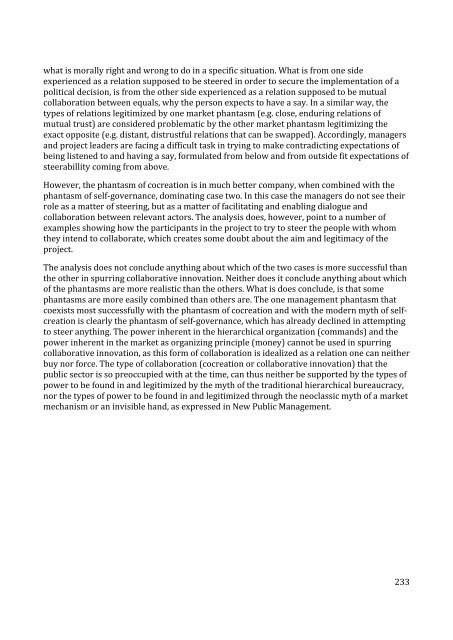phd.Nana
phd.Nana
phd.Nana
You also want an ePaper? Increase the reach of your titles
YUMPU automatically turns print PDFs into web optimized ePapers that Google loves.
what is morally right and wrong to do in a specific situation. What is from one side <br />
experienced as a relation supposed to be steered in order to secure the implementation of a <br />
political decision, is from the other side experienced as a relation supposed to be mutual <br />
collaboration between equals, why the person expects to have a say. In a similar way, the <br />
types of relations legitimized by one market phantasm (e.g. close, enduring relations of <br />
mutual trust) are considered problematic by the other market phantasm legitimizing the <br />
exact opposite (e.g. distant, distrustful relations that can be swapped). Accordingly, managers <br />
and project leaders are facing a difficult task in trying to make contradicting expectations of <br />
being listened to and having a say, formulated from below and from outside fit expectations of <br />
steerabillity coming from above. <br />
However, the phantasm of cocreation is in much better company, when combined with the <br />
phantasm of self-‐governance, dominating case two. In this case the managers do not see their <br />
role as a matter of steering, but as a matter of facilitating and enabling dialogue and <br />
collaboration between relevant actors. The analysis does, however, point to a number of <br />
examples showing how the participants in the project to try to steer the people with whom <br />
they intend to collaborate, which creates some doubt about the aim and legitimacy of the <br />
project. <br />
The analysis does not conclude anything about which of the two cases is more successful than <br />
the other in spurring collaborative innovation. Neither does it conclude anything about which <br />
of the phantasms are more realistic than the others. What is does conclude, is that some <br />
phantasms are more easily combined than others are. The one management phantasm that <br />
coexists most successfully with the phantasm of cocreation and with the modern myth of self-creation<br />
is clearly the phantasm of self-‐governance, which has already declined in attempting <br />
to steer anything. The power inherent in the hierarchical organization (commands) and the <br />
power inherent in the market as organizing principle (money) cannot be used in spurring <br />
collaborative innovation, as this form of collaboration is idealized as a relation one can neither <br />
buy nor force. The type of collaboration (cocreation or collaborative innovation) that the <br />
public sector is so preoccupied with at the time, can thus neither be supported by the types of <br />
power to be found in and legitimized by the myth of the traditional hierarchical bureaucracy, <br />
nor the types of power to be found in and legitimized through the neoclassic myth of a market <br />
mechanism or an invisible hand, as expressed in New Public Management. <br />
233


